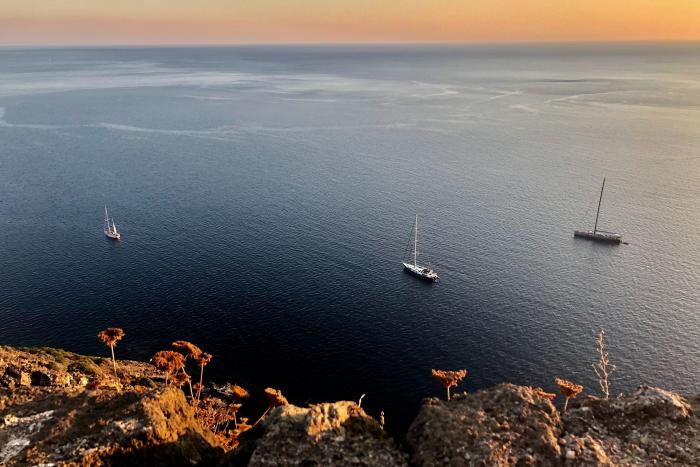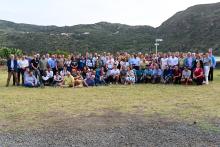
Island facts
Pantelleria is the largest "small island" in the Sicily Region. It is located in the Strait of Sicily, Mediterranian Sea, between Sicily and Tunisia. Its area measures 83 square kilometres and counts about 7,800 inhabitants in winter and about 30,000 in the summertime.
The first evidence of human activity dates back to the Neolithic period by "sesioti". Afterwards, it was occupied by Carthaginians, Romans, Arabs, Aragoneses, Spaniards and Italians. In the past, the main economic activity was agriculture. The agricultural practice of the "vite ad alberello" cultivation was inscribed on the Representative List of the Intangible Cultural Heritage of Humanity of UNESCO.
Its main agricultural product is the "Passito di Pantelleria" wine. In the last decades, the main economic activity became tourism.
The main natural attractions are "Specchio di Venere", "Arco dell'Elefante", "Laghetto delle Ondine", "Balata dei Turchi", and the Gadir Pools. Many tourists own a "Dammuso", the characteristic Pantelleria houses made of local volcanic stones. The island has a set of natural saunas fed by vapours filtering through rocks. This is the reason why Pantelleria is considered a natural free spa. Montagna Grande rises above the centre of the island. It is about 830 metres high, covered by maritime pine woods. To preserve its environment, the Pantelleria National Park was established in 2016. It is the first National Park in the Sicily region which covers 80% of the island area.
Pantelleria is involved in an energy transition path to its total decarbonisation by 2050.
How does Pantelleria produce electricity?
Electricity is currently produced by diesel generators, as the island is not interconnected to the mainland. The means of transport use petrol and diesel engines. About 7% of electricity is produced from about 1 MW of small photovoltaic systems. By 2022, all school buildings, town halls, libraries and municipal dog shelters will be equipped with photovoltaic systems. The Regional Government, the Municipality and the National Park are purchasing electric buses for the island's public transport. Transportation from or to the island is guaranteed by aeroplanes and ferries every day of the year and hydrofoils during summertime. The journey to Sicily takes about 50 minutes by plane, 6 hours by ferry and 2 hours by hydrofoil.
Pantelleria's path to clean energy
Pantelleria began its energy transition path in 2014 with the Covenant of Mayors signature. In 2019 Pantelleria was selected as a pioneer island for the energy transition. Later, in 2020 a group was formed by the Municipality, National Park, the Polytechnic University of Turin and the local energy supply company. Cantine Basile and Resilea drafted the agenda for the energy transition. The Agenda describes the transition process milestones towards total decarbonisation by 2050.
As part of the 30 for 2030 call the following activities are planned:
The hybrid solar and battery storage plant in the airport field will begin with an analysis of the available solar resource, leading to the development of a multi-year data model. This will be accompanied by an assessment of the legal framework necessary for the realisation of the plant, including the required authorisations and any legal framework revisions. The sizing of the hybrid solar and battery plant will be determined based on the requirements communicated by the transition team regarding the storage capacity to photovoltaic capacity ratio, along with an estimation of the associated costs. A feasibility study for the hybrid power plant will be conducted, exploring its potential contribution to an energy community configuration.
For wind power in Arenella, legal and institutional support will be provided for the revision of the regional regulatory framework. A wind resource assessment will be carried out using a multi-year data model at the specifically identified site, employing the Virtual Met Mast tool. This will include an update of the resource map for the island at relevant heights. Furthermore, a long-term yield assessment will be performed for three different turbine models (P50, P75, P90) to determine the optimal layout arrangement, complemented by a photomontage of the identified solution.
In relation to micro-hydro energy in the aqueduct system, a pre-feasibility study will be undertaken to evaluate the potential for valorising hydro energy within the aqueduct system.
Finally, an analysis of the installed charging stations for electric vehicles will be conducted, alongside an examination of the measures already planned or financed in this regard. This will culminate in the development of a plan for the further deployment of charging stations, identifying the necessary sizes and optimal locations.

